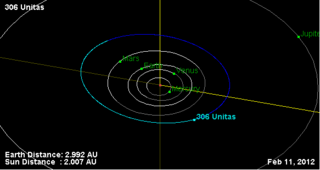Astronomy:306 Unitas
 A three-dimensional model of 306 Unitas based on its light curve | |
| Discovery | |
|---|---|
| Discovered by | Elia Millosevich |
| Discovery date | 1 March 1891 |
| Designations | |
| (306) Unitas | |
| Pronunciation | /ˈjuːnɪtæs/ |
| A891 EA | |
| Minor planet category | Main belt |
| Orbital characteristics[1] | |
| Epoch 31 July 2016 (JD 2457600.5) | |
| Uncertainty parameter 0 | |
| Observation arc | 124.78 yr (45575 d) |
| |{{{apsis}}}|helion}} | 2.71480 astronomical unit|AU (406.128 Gm) |
| |{{{apsis}}}|helion}} | 2.0009 AU (299.33 Gm) |
| 2.35785 AU (352.729 Gm) | |
| Eccentricity | 0.15139 |
| Orbital period | 3.62 yr (1322.4 d) |
| Mean anomaly | 88.9729° |
| Mean motion | 0° 16m 20.014s / day |
| Inclination | 7.2779° |
| Longitude of ascending node | 141.912° |
| 168.008° | |
| Physical characteristics | |
| Dimensions | 46.70±2.3 km[1] 52.88 ± 3.48 km[2] |
| Mass | (5.33 ± 5.77) × 1017 kg[2] |
| Rotation period | 8.736 h (0.3640 d)[1] 8.73875 h[3] |
| Geometric albedo | 0.2112±0.023[1] 0.211[4] |
| S | |
| Absolute magnitude (H) | 8.96[1][4] |
Unitas (minor planet designation: 306 Unitas) is a typical main belt asteroid that was discovered by Elia Millosevich on 1 March 1891 in Rome. The asteroid was named by the director of the Modena Observatory in honor of the Italian astronomer Angelo Secchi (author of Unità delle forze fisiche)[5] and the unification of Italy. It is classified as an S-type asteroid.
In the late 1990s, a network of astronomers worldwide gathered light curve data that was ultimately used to derive the spin states and shape models of 10 new asteroids, including (306) Unitas. The computed shape model for this asteroid is regular, while the light curve displays two maxima per rotation.[3][6] Lightcurve data has also been recorded by observers at the Antelope Hill Observatory, which has been designated as an official observatory by the Minor Planet Center.[7]
Measurements of the thermal inertia of 306 Unitas give an estimate range from 100 to 260 m−2 K−1 s−1/2, compared to 50 for lunar regolith and 400 for coarse sand in an atmosphere.[4]
Although 306 Unitas has an orbit similar to the Vesta family asteroids, it was found to be an unrelated interloper on the basis of its non-matching spectral type. [citation needed]
- Orbir diagram of 306 Unitas
References
- ↑ 1.0 1.1 1.2 1.3 1.4 "306 Unitas". JPL Small-Body Database. NASA/Jet Propulsion Laboratory. https://ssd.jpl.nasa.gov/sbdb.cgi?sstr=306;cad=1.
- ↑ 2.0 2.1 Carry, B. (December 2012), "Density of asteroids", Planetary and Space Science 73: pp. 98–118, doi:10.1016/j.pss.2012.03.009, Bibcode: 2012P&SS...73...98C. See Table 1.
- ↑ 3.0 3.1 Durech, J. et al. (April 2007), "Physical models of ten asteroids from an observers' collaboration network", Astronomy and Astrophysics 465 (1): pp. 331–337, doi:10.1051/0004-6361:20066347, Bibcode: 2007A&A...465..331D.
- ↑ 4.0 4.1 4.2 Delbo', Marco; Tanga, Paolo (February 2009), "Thermal inertia of main belt asteroids smaller than 100 km from IRAS data", Planetary and Space Science 57 (2): pp. 259–265, doi:10.1016/j.pss.2008.06.015, Bibcode: 2009P&SS...57..259D.
- ↑ Schmadel Lutz D. Dictionary of Minor Planet Names (fifth edition), Springer, 2003. ISBN:3-540-00238-3.
- ↑ Durech, J.; Kaasalainen, M.; Marciniak, A.; Allen, W. H. et al. "Asteroid brightness and geometry", Astronomy and Astrophysics, Volume 465, Issue 1, April I 2007, pp. 331–337.
- ↑ "Lightcurve Results". http://www.antelopehillsobservatory.org/index_files/Page334.htm.
External links
- Lightcurve plot of (306) Unitas , Antelope Hills Observatory
- 306 Unitas at AstDyS-2, Asteroids—Dynamic Site
- 306 Unitas at the JPL Small-Body Database
 |


